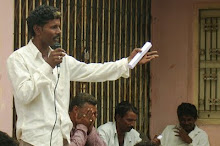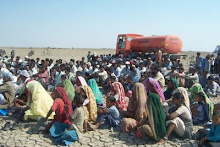UNITED NATIONS TEAM FOR RECOVERY SUPPORT
PROJECT TO IMPROVE THE SOCIO-ECONOMIC CONDITIONS OF SALT WORKERS IN TAMILNADU
Background
PROJECT TO IMPROVE THE SOCIO-ECONOMIC CONDITIONS OF SALT WORKERS IN TAMILNADU
Background
Salt workers are one of the most marginalized and vulnerable sections of the society in Tamil Nadu and other salt producing states of India. As per Central Salt Commissioner’s Office (CSO) supported BOBP-IGO (could you explain abbriviation?) study on India’s salt workers, there are about 150,000 salt workers and their families living for eight months in a year in a harsh environment without basic socio-economic amenities like drinking water, schools, hospitals and knowledge of their statutory rights. It is a labour intensive industry involving risks of blindness, blood pressure, skin lesions, knee injury, back pain and exhaustion, tuberculosis and chronic cough and epidemics such as malaria. Coupled with these issues is the fact that most of the workers are from the backward castes, unorganized, are paid low wages (on a no-work-no-pay basis), and suffer exploitation in the hands of intermediaries in the salt business, including money lenders.[1]
About 20 percent of the workers at the national level are seasonal migrants, which occurs at three levels; inter-village, inter-district and inter-state. Over 90 percent of migrants belong to the first two types where the workers migrate from neighboring districts of salt production zones to salt production centres during the season.
Under the British the growth of the salt sector was affected in India due to the heavy taxes imposed, forcing import of salt from Britain. The situation is markedly better now. India’s salt industry, with 17 million tones produced, is the third highest in the word. Tamil Nadu accounts for 14% of the above figure. The salt industry is governed by the Salt Cess Act of 1953, which is implemented through the Salt Commissioner’s Office, headquartered in Jaipur.
Impact on the Salt workers lives
The salt industry was hard hit by the 26 December 2004 Tsunami. The loss was mainly to the infrastructure, delay in production following intrusion of sea water in the condensors and reservoirs and loss of salt in stock.
In Vedaranyam, the salt production season is December to September. However up to April 2005 enough brine was not available. Due to tsunami waves, protective bunds, roads, bittern channels, brine pits were damaged extensively. The vedaranyam salt producers association has estimated loss of Rs. 25,000 per acre. Most of the workers remained unemployed after the tsunami damaged the saltpans. The SCO had sanctioned INR 57 lakhs for rehabilitation and planting mangrove trees along 500 metres area from the seashore.
The economic impact was in three forms:
1. Loss of prepared salt
2. Loans taken from moneylenders that remain outstanding
3. Sustaining oneself until the reclamation of brine pits is done and a new lot of produced salt is in place.
The Salt workers were one of most impacted communities after the tsunami though there was no extensive damage to life. Ever since then, there has been a need to run cross-sectoral programmes, habitat development and equity issues benefiting the salt workers.
National consultation
In pursuance of the above need the UNTRS organized a National level consultative meeting on 11th April, 2007, along with the Salt Commissioner’s office, at Jaipur. Participants and agencies represented at this consultation were the salt commissioner and his deputy, UNICEF, WFP, Industries department, UNDP, American India foundation, labour department, NGOS (Basix, Manthan). An overview of the needs of the salt workers, areas of priority and the schemes to be announced under the 11th Central Plan were discussed. The recommendations of the BOBP-IGO report on salt workers were also appreciated in this meeting:
- Create a data base on salt workers. Undertake a full census. Register all salt workers.
- Guarantee employment, fix minimum wages.
- Improve workplace amenities, such as access to potable drinking water, mobile clinics, protective gear, sanitation, rest sheds.
- Strengthen awareness on family planning. Recruit health workers from salt workers’ community.
- Set up a group insurance scheme. Improve and widen the credit access.
- Set up child crèches and schools. Mobilize NGOs for the same purpose.
- Modernize the industry without marginalizing small-scale salt units. Standardize production techniques. Improve power supply. Set up salt parks in select locations.
- Strengthen infrastructure for storage and transport of salt, jetties and efficient rail rakes.
It was also discussed in this meeting to start work in Tamil Nadu by forming an advisory group and initiating a baseline which could guide the intervention.
A state level stakeholders meeting was held in Chennai on 31st May, 2007, to analyze the key issues that need to be focused for intervention from the perspective of all participants which comprised representatives from salt workers, the Deputy Salt Commissioner, Tamil Nadu Salt Corporation, American India Foundation, Faces (NGO), Women’s Collective (NGO), Anasuya Foundation, Tata Chemicals, Orchid Pharma, and Hindustan Lever Limited. The meeting gave very useful insights on the salt workers issues, it mainly:
1. articulated the need and role of such an advisory group at the state level for the benefit of salt workers programmes,
2. key issues that need to be focused in Tamil Nadu
3. the terms of reference for a situation analysis was finalized
The situation analysis being conducted by the Vrutti - Livelihood Resource, Centre Catalyst Development Initiatives, has been initiated in September 2007 for a two month period, is expected to provide a clear design to implement a project to improve the socio-economic conditions of the salt workers. Clarity needs to emerge on the number of salt pan workers we are addressing, the specific issues in the tsunami and non tsunami context, and mainly a clear baseline to take this forward. This situation analysis will further result in designing a project design to improve the lives of salt workers.
Partnership strategy:
The project will be implemented in partnership with the Salt commissioner’s office (Government of India) and civil society organizations. Where required linkages will be established with Corporate Houses and other UN agencies to facilitate the implementation of the project.
[1] BOBP-IGO Condensed Report ‘Socio Economic Status of Workers in the Salt Industry’, 37, Bay of Bengal News March 2006
















.jpg)
.jpg)
.jpg)
.jpg)













No comments:
Post a Comment